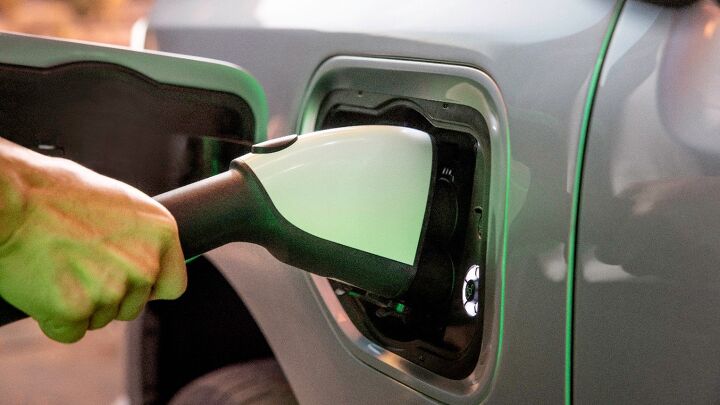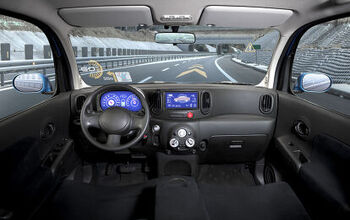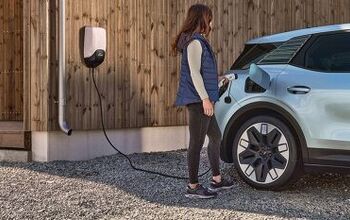Ford Scales Back Michigan Battery Plant Investments

Ford has said it will restart construction on the electric vehicle battery facility it’s building in Marshall, Michigan, after pausing work when the UAW strike kicked off a couple months ago. But the company has also announced that it would be “re-timing and resizing some investments.”
From Ford:
While we remain bullish on our long-term strategy for electric vehicles, we are re-timing and resizing some investments. As stated previously, we have been evaluating BlueOval Battery Park Michigan in Marshall.
We are pleased to confirm we are moving ahead with the Marshall project, consistent with the Ford+ plan for growth and value creation. However, we are right-sizing as we balance investment, growth, and profitability. The facility will now create more than 1,700 good-paying American jobs to produce a planned capacity of approximately 20 GWh.
We still expect BlueOval Battery Park Michigan to be the first of Ford’s battery plants of this kind when it begins producing LFP battery cells starting in 2026.
Ford had originally announced that the Blue Oval Battery Park would result in 2,500 jobs. The new 20 GwH capacity also shaves a fifth off the company’s initial estimate. Mark Truby, chief communications officer for Ford, noted this would likewise result in the $3.5 billion investment shrinking to roughly $2.2 billion.
“We’ve been studying this project for the past couple of months, and I think we’re all aware that EV adoption is growing, and we expect that to continue actually, but it’s not growing at the pace that I think ourselves and the industry had expected,” Truby was quoted by Automotive News as saying during a press call.
While the facility was a big deal for Michigan residents wanting to see more domestic automotive jobs, it’s also become a contentious issue on the national stage. Ford’s battery manufacturing is supposed to be done by licensing technology from China’s Contemporary Amperex Technology Co (CATL) and the issue has raised questions about national security and whether or not subsequent Ford products would be eligible for federal tax credits that are now tied to regional content requirements.
Though Ford has said its primary concerns stem from demand. It’s a claim one might be inclined to agree with if they’ve been following the market.
With so much government pressure to build EVs and assumptions that they would ultimately become more profitable than combustion vehicles, legacy manufacturers were eager to follow Tesla into the land of profitable electrification.
However, the public doesn’t appear sufficiently interested and the relevant technologies aren’t yet up to par. Tesla has remained the exception, rather than the rule. Meanwhile, EVs continue to be priced much higher than their combustion counterparts with demand being isolated primarily to metropolitan hubs and the wealthier surrounding suburbs. Segment growth is slowing and the industry is starting to act a little more cautious as the novelty of electric cars begins to wear off.
Dealers don’t seem to be particularly enthusiastic about electrification anymore either. Numerous brands (including Ford) have tied EV allocations to costly renovations that include on-site charging stations. The vehicles themselves are getting harder to move — something literally every dealer source I have has expressed to me this year. But we don’t technically need them to tell us, as the data speaks for itself. Both electric and combustion vehicles went into 2023 with a roughly 50-day supply. While that has remained more-or-less the case for gas-powered automobiles, the supply of battery vehicles has nearly doubled through October.
With the above in mind, Ford has likewise opted to scale back its electric vehicle certification program intended for dealers. The explanation given was that the Blue Oval needed to “adapt [its] overall EV strategy to the market and listen to dealer feedback.”
For specifics on the tweaked certification plan, check out Matthew Guy’s article covering the topic or some of our earlier pieces examining the legal issues surrounding the matter.
Expect to see media outlets bashing Ford for scaling back EV investments in the near term. You’ll also probably notice the stock market reacting unfavorably to the news for a time. In fact we saw the brand’s valuation slip a bit almost immediately after the two announcements were made. But Ford actually seems to be making the correct choice for itself here, even if Wall Street is blind to the fact. The automaker’s electric vehicle division is projected to lose $4.5 billion by the end of 2023 and wastes an estimated $36,000 on every EV it currently sells.
Investors have been on an impulsive tech binge for far too long and the fact remains that most automakers pressing forward with electrification haven’t seen great returns on their investment. As unfortunate as it is to see Blue Oval Battery Park being scaled back, it’s probably the correct move for the company to make at this juncture. Pragmatism may not be the best way to pump up the share price and tempt today's overeager investors. But it’s undoubtedly wiser than sticking with an existing plan that doesn’t seem to be working out for the broader industry.
[Image: Ford Motor Co.]
Become a TTAC insider. Get the latest news, features, TTAC takes, and everything else that gets to the truth about cars first by subscribing to our newsletter.

A staunch consumer advocate tracking industry trends and regulation. Before joining TTAC, Matt spent a decade working for marketing and research firms based in NYC. Clients included several of the world’s largest automakers, global tire brands, and aftermarket part suppliers. Dissatisfied with the corporate world and resentful of having to wear suits everyday, he pivoted to writing about cars. Since then, that man has become an ardent supporter of the right-to-repair movement, been interviewed on the auto industry by national radio broadcasts, driven more rental cars than anyone ever should, participated in amateur rallying events, and received the requisite minimum training as sanctioned by the SCCA. Handy with a wrench, Matt grew up surrounded by Detroit auto workers and managed to get a pizza delivery job before he was legally eligible. He later found himself driving box trucks through Manhattan, guaranteeing future sympathy for actual truckers. He continues to conduct research pertaining to the automotive sector as an independent contractor and has since moved back to his native Michigan, closer to where the cars are born. A contrarian, Matt claims to prefer understeer — stating that front and all-wheel drive vehicles cater best to his driving style.
More by Matt Posky
Latest Car Reviews
Read moreLatest Product Reviews
Read moreRecent Comments
- Steve S. Steve was a car guy. In his younger years he owned a couple of European cars that drained his bank account but looked great and were fun to drive while doing it. This was not a problem when he was working at a good paying job at an aerospace company that supplied the likes of Boeing and Lockheed-Martin, but after he was laid off he had to work a number of crummy temp jobs in order to keep paying the rent, and after his high-mileage BMW was totaled in an accident, he took the insurance payout and decided to get something a little less high maintenance. But what to get? A Volkswagen? Maybe a Volvo? No, he knew that the parts for those were just as expensive and they had the same reputation for spending a lot of time in the shop as any other European make. Steve was sick and tired of driving down that road."Just give me four wheels and a seat," said Steve to himself. "I'll buy something cooler later when my work situation improves".His insurance company was about to stop paying for the rental car he was driving, so he had to make a decision in a hurry. He was not really a fan of domestics but he knew that they were generally reliable and were cheap to fix when they did break, so he decided to go to the nearest dealership and throw a dart at something.On the lot was a two year old Pontiac Sunfire. It had 38,000 miles on it and was clean inside and out. It looked reasonably sporty, and Steve knew that GM had been producing the J-car for so long that they pretty much worked the bugs out of it. After taking a test drive and deciding that the Ecotec engine made adequate power he made a deal. The insurance check paid for about half of it, and he financed the rest at a decent rate which he paid off within a year.Steve's luck took a turn for the better when he was offered a job working for the federal government. It had been months since he went on the government jobs website and threw darts at job listings, so he was surprised at the offer. It was far from his dream job, and it didn't pay a lot, but it was stable and had good benefits. It was the "four wheels and a seat" of jobs. "I can do this temporarily while I find a better job", he told himself.But the year 2007 saw the worst economic crash since the Great Depression. Millions of people were losing their jobs, the housing market was in a free fall, people were declaring bankruptcy left and right, and the temporary job began to look more and more permanent. Steve didn't like his job, and he hated his supervisors, but he considered himself lucky that he was working when so many people were not. And the federal government didn't lay people off.So he settled in for the long haul. That meant keeping the Sunfire. He didn't enjoy it, but he didn't hate it either, and it did everything he asked of it without complaint.Eventually he found a way to tolerate his job too, and he built seniority while paying off his debts. There was a certain feeling of comfort and satisfaction of being debt-free, and he even began to build some savings, which was increasingly important for someone now in their forties.Another bit of luck came a few years later when Steve's landlord decided to sell the house Steve was renting, at the bottom of the housing market, and offered it to Steve for what he had in it. Steve's house was small and cramped, and he didn't really like it, but thanks to his savings and good credit he became a homeowner in an up and coming neighborhood.Fourteen years later Steve was still working that temporary job, still living in that cramped little house that he now hated, and still drove the Sunfire because it wouldn't die. For years now he dreamed of making a change, but then the pandemic happened and threw the economy and life in general into chaos. Steve weathered the pandemic, kept his job when millions of people were losing theirs, and sheltered in place in that crummy little house, with Netflix, HBO, and a dozen other streaming services keeping him company, and drove to and from work in the Sunfire because it was four wheels and a seat and that's all he needed for now.Steve's life was secure, but a kind of dullness had set in. He existed, but the fire went out; even when the pandemic ended and life returned to normal Steve's life went on as it had for years; an endless Groundhog Day of work, home, work, home. He never got his real-estate license or finished college and got his bachelor's, never got a better job, never used his passport to do some traveling in Europe. He lost interest in cars. "To think how much money I wasted on hot cars when I was younger", he said to himself. He never married and lost interest in dating. "No woman would want me anyway. I've gotten so dull and uninteresting that I even bore myself".Eventually the Sunfire began to give trouble. With 200,000 miles on the clock it was leaking oil, developing electrical gremlins, and wallow around on blown-out shocks. Steve wasn't hurting for money and thought about treating himself to a new car. "A BMW 3-series, maybe. Or maybe an Alfa Romeo Giulia!" He began to peruse the listings on Autotrader. "Maybe this is just what I need to pull out of this funk. Put a little fun back in my life. Yeah, and maybe go back to the gym, and who knows, start dating again and do some traveling while I'm still young enough to enjoy it!"Then his father passed away and left him a low-mileage Ford. Steve didn't like it or hate it, but it was four wheels and a seat, and that's all he needed right now."Is it too late to have a mid-life crisis?" Steve thought to himself. For what he needed more than that stable job, that house with an enviably small mortgage payment, and that reliable car was a good kick in the hindquarters. "What the hell am I afraid of? I should be afraid that things will never change!"But the depression was like a drug, a numbness that they call "dysthymia"; where you're neither here or there, alive or dead, happy or sad. It was a persistent overcast, a low ceiling that kept him grounded. The Sunfire sat in his driveway getting buried by the needles from his neighbor's overhanging pine trees which were planted right on the property line. "Those f---ing pine trees! That's another thing I hate about this damn house!" Eventually the Sunfire wouldn't start. "I don't blame you", he said to the car as he trudged past it to drive the Ford to another Groundhog Day at that miserable job.
- Yuda Cool. Cept we need oil and such products. Not just for fuel but other stuff as well. The world isn't exactly ready to move to wind and solar and whatever other bs, the technology simply isn't here yetNot to mention it's too friggin expensive, the equipment is still too niche and expensive as it stands
- Rna65689660 Picked up my wife’s 2024 Bronco Sport Bad Lands!
- Inside Looking Out Android too.
- Ajla I'm replacing the transmission in a 2006 GMC van.


































Comments
Join the conversation
Hard to make a profit when electrons are the sole source of propulsion.
Oracle, your words are meaningful and appreciated. thank you.